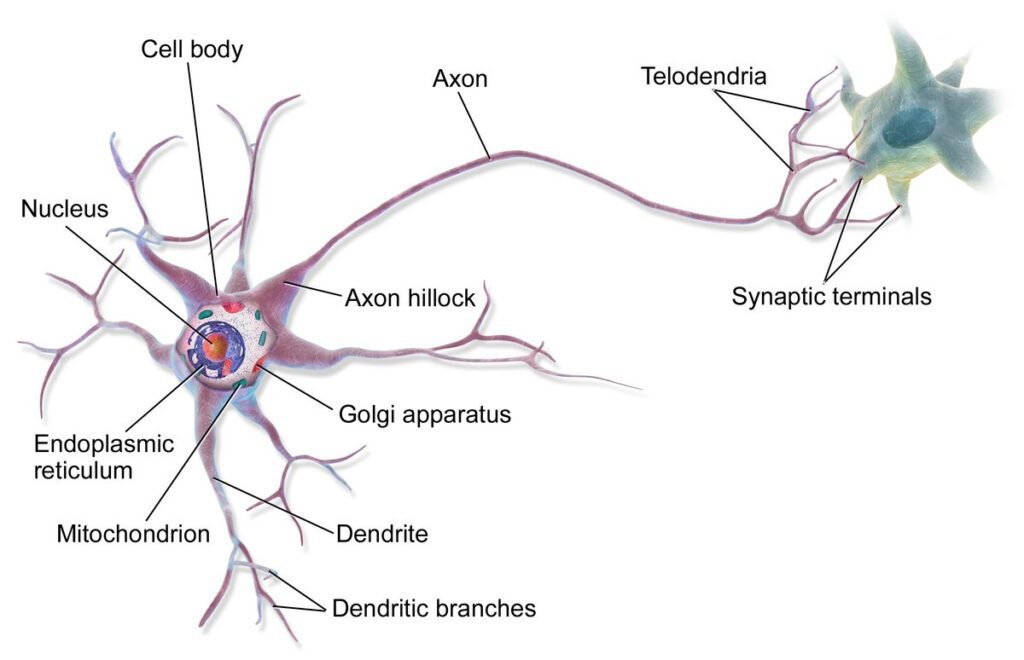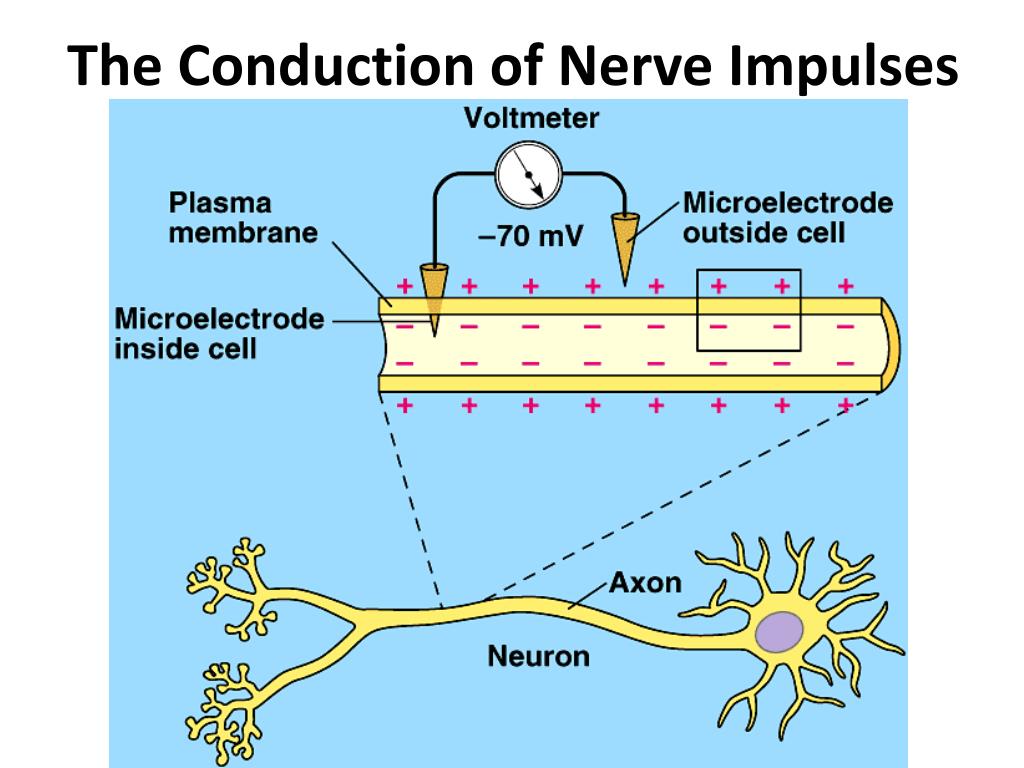The human body is made up of trillions of cells. Among them, nerve cells, or neurons, are very special. They are the messengers of the body. Neurons carry information from one part of the body to another. This information travels in the form of nerve impulses.
A nerve impulse is like an electrical signal. It allows the brain to talk to different parts of the body and for the body to send information back to the brain. Without nerve impulses, we wouldn’t be able to think, feel, move, or even breathe.

Let’s explore how nerve impulses are created and how they travel from one neuron to another. This process is called nerve impulse conduction.
Table of Contents
What is a Neuron?
Before we understand how nerve impulses move, it’s important to understand the structure of a neuron.

A typical neuron has three main parts:
- Cell Body (Soma): This is the central part of the neuron. It contains the nucleus and other organelles needed for the cell to stay alive and function.
- Dendrites: These are small branches that come out of the cell body. They receive signals from other neurons.
- Axon: This is a long, thin fiber that carries the nerve impulse away from the cell body. Some axons are very short, while others can be as long as a meter.
The end of the axon branches out and forms connections with other neurons, muscles, or glands. These connections are called synapses.
The Resting State of a Neuron
When a neuron is not sending a signal, it is said to be in a resting state. During this time, there is a difference in electrical charge across the neuron’s cell membrane.
- Outside the neuron: there are more positive ions (like sodium, Na⁺).
- Inside the neuron: there are more negative ions (like proteins and potassium ions, K⁺).
This creates a voltage difference, usually around -70 millivolts (mV), known as the resting membrane potential.
This state is maintained by the sodium-potassium pump, a protein in the cell membrane. It pushes 3 sodium ions out and brings 2 potassium ions in, using energy (ATP). This keeps the inside of the neuron more negative than the outside.
What Triggers a Nerve Impulse?
A nerve impulse begins when a neuron gets a stimulus strong enough to change its membrane potential. This stimulus can come from another neuron, a chemical, or a change in the environment (like touching something hot).
If the stimulus is strong enough to reach a certain level called the threshold (around -55 mV), the neuron will fire a signal. This signal is called an action potential.
The Action Potential: How the Impulse Starts
When the threshold is reached, voltage-gated sodium channels open. This allows sodium ions (Na⁺) to rush into the neuron. Because sodium ions are positively charged, they make the inside of the neuron more positive. This process is called depolarization. In just a few milliseconds, the membrane potential changes from -70 mV to about +30 mV. This sudden change in electrical charge is the action potential — the nerve impulse itself.
Repolarization and the Return to Resting State
After the action potential peaks at +30 mV, the neuron needs to reset so it can fire again.
- The sodium channels close.
- The potassium channels open, and K⁺ ions flow out of the neuron.
This causes the inside of the neuron to become negative again. This phase is called repolarization. Sometimes, too many potassium ions leave the cell, making the inside even more negative than the resting state. This is called hyperpolarization. Eventually, the sodium-potassium pump restores the original ion balance, and the neuron returns to its resting state, ready to fire again.
How the Impulse Moves Along the Axon
Once the action potential starts in one part of the axon, it spreads to the next part, like a wave. The influx of sodium in one area causes nearby channels to open, and the process repeats. This chain reaction continues until the nerve impulse reaches the end of the axon. This movement is called propagation of the nerve impulse. There are two types of conduction:
1. Continuous Conduction (in Unmyelinated Neurons)
In unmyelinated neurons, the action potential moves step-by-step along the entire length of the axon. It’s like a domino effect — one section of the membrane fires, then the next, and so on. This process is slower because every part of the axon must be activated.
2. Saltatory Conduction (in Myelinated Neurons)
In many neurons, the axon is covered with a fatty layer called the myelin sheath. This acts like insulation around a wire. It is not continuous — there are gaps in the myelin called Nodes of Ranvier. In these neurons, the nerve impulse jumps from one node to the next. This is called saltatory conduction (from the Latin saltare, meaning “to jump”). Saltatory conduction is much faster than continuous conduction because the signal skips over the insulated parts.
The Role of the Synapse
When the nerve impulse reaches the end of the axon, it needs to be passed to the next neuron or to a muscle or gland. This happens at the synapse — a tiny gap between two cells.
Here’s how it works:
- The impulse reaches the end of the axon (axon terminal).
- It causes calcium ions (Ca²⁺) to enter the terminal.
- This triggers the release of neurotransmitters, which are chemical messengers.
- Neurotransmitters cross the synapse and bind to receptors on the next neuron.
- If the signal is strong enough, a new action potential begins in the next neuron.
Common neurotransmitters include acetylcholine, dopamine, serotonin, and norepinephrine.
Why Nerve Impulses Move in One Direction
Nerve impulses always travel in one direction — from dendrites to the axon terminal. This is because:
- The receptors for neurotransmitters are only on the receiving side of the synapse.
- After firing, the part of the neuron enters a short refractory period, where it cannot fire again immediately. This ensures that the impulse doesn’t go backward.
Factors Affecting the Speed of Nerve Impulse Conduction

Several factors influence how fast a nerve impulse travels:
1. Myelination
- Myelinated neurons conduct signals faster.
- Saltatory conduction in myelinated axons is more efficient.
2. Axon Diameter
- Thicker axons conduct impulses faster because they have less resistance.
3. Temperature
- Warmer temperatures generally speed up nerve conduction.
- That’s why your reflexes might be slower when you’re very cold.
Importance of Nerve Impulse Conduction
Nerve impulse conduction is essential for everything our bodies do. Here are just a few examples:
- Touch: When you touch something hot, sensory neurons send an impulse to the brain and spinal cord. A motor impulse is sent back to move your hand away.
- Vision and Hearing: Special neurons in the eyes and ears convert light and sound into nerve impulses that the brain can understand.
- Thought and Emotion: Even thinking, learning, and feeling emotions depend on nerve impulses traveling between different parts of the brain.
- Movement: Every muscle movement — from blinking to running — depends on motor neurons sending impulses to the muscles.
Disorders Related to Nerve Impulse Conduction
When nerve impulse conduction is disrupted, serious problems can occur. Some examples include:
1. Multiple Sclerosis (MS)
- In this condition, the immune system attacks the myelin sheath.
- Without myelin, impulses slow down or stop.
- Symptoms include muscle weakness, vision problems, and difficulty walking.
2. Epilepsy
- In epilepsy, neurons sometimes fire too many impulses at once.
- This causes seizures — sudden bursts of electrical activity in the brain.
3. Peripheral Neuropathy
- Damage to peripheral nerves (outside the brain and spinal cord) causes weakness, numbness, or pain.
Conclusion
Nerve impulse conduction is one of the most important processes in the human body. It allows us to sense, move, think, and survive. This process depends on the careful flow of ions across the neuron’s membrane, the creation of an action potential, and the transmission of signals from one cell to another through synapses.
Whether it’s a simple reflex or a complex thought, every action starts with a nerve impulse. Understanding how these impulses work helps us better understand the nervous system, and how to treat diseases that affect it.
So the next time you blink, smile, or remember something, know that your neurons are hard at work — sending tiny electrical signals at lightning speed to keep you going.
FREQUENTLY ASKED QUESTIONS
What is a nerve impulse?
A nerve impulse is an electrical signal that travels along a neuron. It allows communication between the brain, spinal cord, and different parts of the body.
What triggers a nerve impulse?
A nerve impulse is triggered when a neuron receives a stimulus strong enough to reach a threshold. This opens sodium channels and starts an action potential.
Why do nerve impulses move in one direction?
They move in one direction because:
Neurotransmitters are only released from the axon terminal.
The neuron enters a refractory period, which prevents it from firing again immediately.
Related Articles




